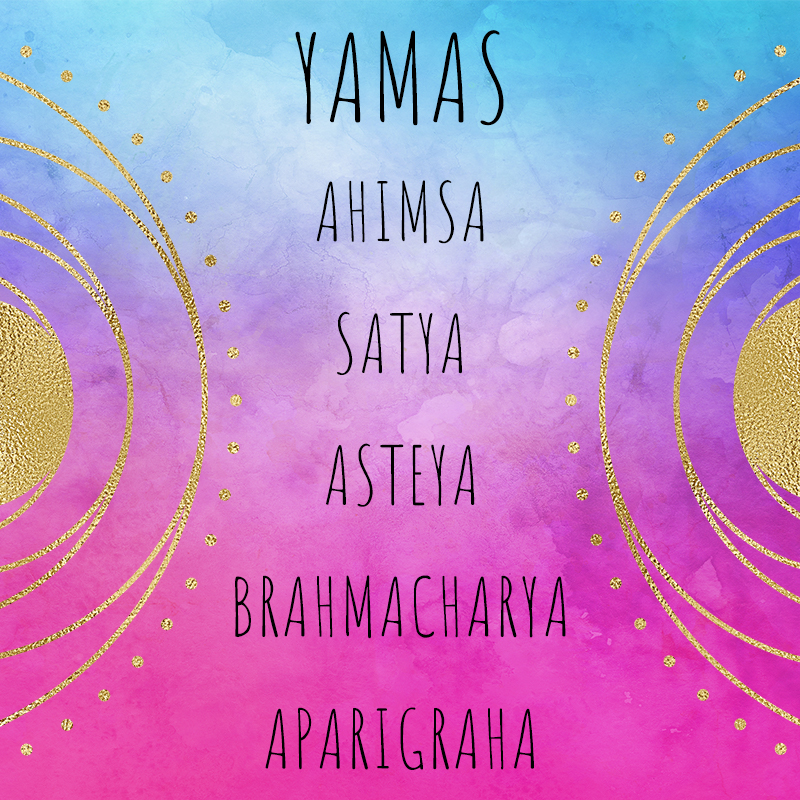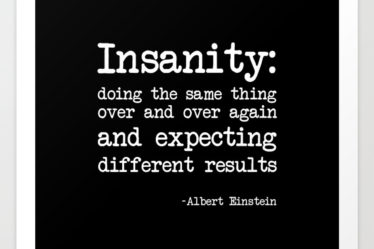
If you didn’t already read part 1 of this series, go back and check it out (Taking Yoga OFF the Mat: Part 1 — The 8 Limbed Path). It gives you a basic background on the 8 limbed path of yoga and will help you understand where we are headed for the next few weeks.* And if you already read it, GREAT! Let’s get started 🙂
The first and second limbs of the 8 limbed path are the Yamas and Niyamas. These two each offer 5 ethical guidelines for your behavior. Yamas are the moral restraints for how you behave outwardly toward others. Niyamas are guidelines for how to treat yourself. In truth I could surely write an entire post for each of the moral imperatives, but that’s probably taking it a bit too far right now.
I’ll give you the Cliffs Notes version of the Yamas today and we’ll tackle the Niyamas next time.
As I mentioned, there are 5 Yamas (Ahimsa, Satya, Asteya, Bhramacharya, and Aparigraha). We’ll break each one down and see how they can be applied to your practice AND more importantly, to your life OFF the mat.
- Ahimsa is translated as non-harming. The prefix “a ” in sanskrit means “non / not” or “lack of,” and “himsa” is harm. To put it in its simplest terms, and when I taught kids yoga I used to teach that it means kindness to others. Kindness (or non-harming) in your words, thoughts, and actions (and inaction!). Woah, non-harming thoughts. That one is tough. It’s a pretty tall ask for a lot of us not to have a flittering bad thought about others (and OURSELVES), but even if you can manage to take pause long enough to NOTICE the thought as it comes into your awareness that’s a start. Our thoughts and our words become our reality and our truth — and your thoughts and words can become someone else’s reality and truth if they are repeated enough times. This is also why positive affirmations are so important–to let the positive self talk become your truth. And speaking of truth…
- Satya means truthfulness. This one seems pretty simple, and if you grew up with any Christian influences like I did, iit sounds pretty familiar — perhaps like one of the ten commandments (though shall not lie). However it’s a little more complicated than it seems. Yes, you should not lie to others outright. You should also not lie by omission, nor should you say everything on your mind (even if it IS true) if it will cause harm to others (go back and see #1). Satya also asks us to consider what is REALLY the truth and what is our own individual perceptions of reality based on our prejudices and biases — our opinion or just our skewed version of what is really happening in the world around us.
- Asteya means non-stealing. Again, this also seems pretty simple (and perhaps like another commandment?). Clearly one should not steal physically from others. But there are ways that we behave that steal from those around us that are more important than physical possessions. When you are late for a class / appointment / meeting you are stealing someone else’s time. When I have to repeat my instructions too many times to count, or go 18 rounds on why one must wear a hat when it’s 20 degrees outside with my children, they are stealing my time and my energy (both precious resources). In fact, this example is a big one in my house. I can’t even begin to tell you how often they have zapped my energy well before dinner time and I literally have nothing left to give before the day is done. That said, I should consider the next Yama before I go pointing the finger of blame.
- Bhramacharya has many interpretations and some say it means celibacy, but others translate it a bit more loosely to mean right use of energy, moderation, or balance. Where your attention goes energy flows, so this yama asks us to consider if we are sending our energy to the right places. Are we putting excess effort or mental energy into stresses that cannot be resolved by our own thoughts and actions? Are we spending hours scrolling through news feeds that anger or upset us? Practicing bhramacharya helps us to choose wisely when deciding how to spend our own energy resources—should I really choose to spend my day repeating the same instructions over and over, or explaining the various reasons why one should where a hat when the temperature is below freezing — is that really the hill I should choose to die on?? I seem to have a lot of parenting examples here, but this can also mean not getting wrapped up or engaged in the emotional responses (to seemingly trivial things) that our children have regularly. If I can manage to stay neutral and tell them I’m not getting involved in whatever nonsense they are arguing about, I don’t spend MY valuable energy. I don’t get worked up and inevitably angry or upset. I am not a referee. I am Switzerland and I am at peace.
- Aparigraha means non-grasping or non-covetousness. This is like the Marie Kondo of Yamas. It directs us to let go of the things we don’t need and only take / use what we must. This can be physically AND mentally. Clinging to thoughts, feelings, emotions, and ideas that no longer serve us (or that may not even be true) can be just as harmful, and I would argue ,uch more so, than hanging on to that 20 year old t-shirt. Letting go of hurt feelings can be a tough one, BUT that really is the way to free your own mind. Forgiving another person for the hurt they’ve caused you does not imply that their actions were okay or correct, it simply allows you to stop clinging to the pain and mental suffering caused by someone else’s actions (that you couldn’t control in the first place).
Okay, so we have our 5 moral imperatives for how to treat others and I think you can see pretty clearly how they can be applied OFF the mat and in your daily life. Following these ethical guidelines can lead to a sense of mental calmness and perhaps even an inner peace. This is no easy task, it takes a lot of practice and patience. You will make mistakes. You will struggle and flounder along the way (no one is perfect!), but there are lessons to be learned by doing the work. By putting your best effort towards living a life with awareness (of ourselves and others) we can absolutely become better human beings and improve our relationships with the world around us.
*Caveat / Disclaimer: Please keep in mind I am sharing with you my current understanding of these very complex ideas. I am a middle-aged white woman from the midwest and have only spent the last 6 or 7 years studying this ancient tradition. I implore you to consider these factors, and absolutely seek out other resources to dive deeper for yourself. I also invite you to share YOUR knowledge, in a kind and thoughtul manner, and offer different interpretations of the ideas I have presented as a way for us to all learn and grow.*



[…] overview of the 8 limbed path (HERE) and covered the first limb last week – the Yamas (HERE). Today we will look at the second limb, the Niyamas, or the guidelines for how to treat […]
[…] awareness internally. This limb is actually the bridge between our external practices of yoga (Yamas, Niyamas, Asana, and Pranayama) to the INTERNAL practices. The last 4 limbs moves us closer and […]